Environmental Engineering Reference
In-Depth Information
Fig. 6.3
Interconnected subsystems
The wind turbine is a highly nonlinear system. The nonlinearity is caused by the
conversion of wind to electrical power. According to [
10
], the extracted electrical
power from the wind can be formulated as
P
a
¼
1
2
qpR
2
t
3
C
p
k
;
b
ð
Þ
:
ð
6
:
1
Þ
The dimensionless tip-speed-ratio (TSR) k is defined as
k
¼
x
r
R
t
ð
6
:
2
Þ
;
where x
r
is the rotational speed of the rotor, R is the rotor radius and t is the wind
speed acting on the blades. From (
1
) the expressions for the aerodynamic torque
and thrust force are found as follows:
T
a
¼
1
2
qpR
3
t
2
C
p
k
;
b
ð
Þ
ð
6
:
3
Þ
;
k
F
t
¼
1
2
qpR
2
t
2
C
T
k
;
b
ð
Þ
:
ð
6
:
4
Þ
where T
a
is the aerodynamic torque, F
t
is the thrust force, q is the air density and b
is the blade pitch angle. C
p
is known as the power coefficient and depends on how
the turbine is designed. It is an expression describing the relationship between
power available in the wind and how much it is possible to extract. It is not
possible to extract all the wind. If this were to happen, then the wind would have to
completely stop after hitting the blades. The theoretical upper limit for the power
extraction is known as the Betz limit. Albert Betz showed that only 59.3 % of the































































